 Earlier this week I was walking down Main Street in town, and I noticed some fruit in a tree. It was a Ginkgo Biloba tree, also known as a Maidenhair Tree, which I recognized by the fan-shaped leaves. But I didn’t know if the fruit was edible, so my research began.
Earlier this week I was walking down Main Street in town, and I noticed some fruit in a tree. It was a Ginkgo Biloba tree, also known as a Maidenhair Tree, which I recognized by the fan-shaped leaves. But I didn’t know if the fruit was edible, so my research began.
Ginkgo trees have an interesting history. Fossil remains show us that they grew when dinosaurs roamed the Earth. They were dubbed “living fossils” by Charles Darwin. Interestingly enough, a 3000-year-old Ginkgo Biloba tree has been reported recently in China. The Gingko now survives only in cultivation. Native to China, it was introduced into the New World in 1784 by William Hamilton in his garden near Philadelphia. Ginkgos are tolerant of difficult soils and air pollution which make them popular as an ornamental shade tree for city streets – hence, a unique urban edible food source.
The female Ginkgo bears fruit that is known for it’s obnoxious smell, resembling rancid butter when the pulp is deteriorating on the ground. The fleshy, yellow-brown fruit-like part of the seed is toxic, and with long-term repeated contact can cause dermatitis. Once it is removed, it reveals the nut which is protected by a brown, paper-thin skin, just like the peanut. Remove the paper-thin layer and the seed can be eaten raw (in small quantities), or (in larger quantities) it can be cooked by roasting over an open fire or boiled and used in soups or porridges. The heating process kills offending chemicals that render it safe and tasty.
So, now we know another food source that just might come in handy. Keep your eyes open next time you take a neighborhood stroll.



My puppy likes to eat the fruit off the ginkgo biloba tree, and I was wondering if this is going to hurt her? Thank you for a reply.
Shirley
The pulp would be toxic and should not be eaten. The nut inside is edible in small quantities but long term should be roasted or boiled. You can consult a veterinarian for more specifics.
Ken is mistaken about the pulp of the ginkgo biloba tree. The fruit is actually medicinal and edible but only in small bites, 1/4 of the fruit at a time, otherwise it can become noxious. The fruit can be frozen for many months and still have its medicinal effect. Within one week of eating the pulp and nut daily, I experienced improved short term memory. South Koreans are familiar with the fruit pulp for this purpose. The fruit pulp is highly misrepresented in the U.S. Someday, this will change. The seeds are found in asian grocery stores. The fruit that is made up of both pulp and seed is hard to find unless you know of such trees in your city.